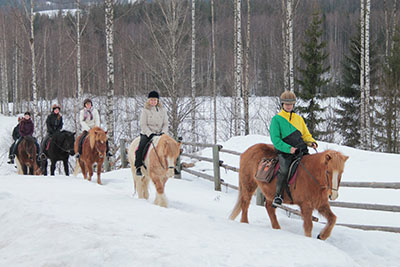There were approximately 3.2 million visits to Finnish national parks in 2018, which means 2% growth over the previous year. The impact of national park visitor spending on local communities increased 2%, currently amounting to over EUR 211 million. Although growth rates have varied from year to year, the overall trend is steadily rising. At the same time, there is a threat of decrease in budget funding for national parks. This, in turn, threatens both the sustainability and the economic and health benefits of tourism.
 Visitation at all destinations managed by Metsähallitus, Parks & Wildlife Finland totalled approximately 6.9 million in 2018. Growth in the number of visits to national hiking areas increased by as much 11%. All growth figures are an indication of an increase in the popularity of nature tourism and outdoor recreation as well as a diversification of site use.
Visitation at all destinations managed by Metsähallitus, Parks & Wildlife Finland totalled approximately 6.9 million in 2018. Growth in the number of visits to national hiking areas increased by as much 11%. All growth figures are an indication of an increase in the popularity of nature tourism and outdoor recreation as well as a diversification of site use.The health benefit experienced by visitors also increased: over 88% of all visitors felt that outdoor recreation had a moderate or high health and well-being impact. On average, visitors estimated the health benefit of visits to nature sites to be worth EUR 110 per visit.
Funding for Parks & Wildlife Finland from the state budget is, in accordance with central government spending limits, declining. At the same time, visitor numbers increase, the amount of protected areas is on the rise, and their importance to well-being and the economy grows in importance. This means that there is less and less money available per visitor.
– This is very regrettable, because the needs of visitors to national parks and other nature sites have increased and become more differentiated, and the number of international visitors has also increased, explains Parks & Wildlife Finland Director Timo Tanninen.
Parks & Wildlife Finland has already reformed its service offering to meet the current demand and reduced services and constructions that are infrequently used or at the end of their lifecycle. Other measures designed to improve the cost-effectiveness of operations have already been taken, and active efforts are being made to acquire external funding. Operations of Parks & Wildlife Finland are, however, based on state budget funding, whose reduction would inevitably lead to a deterioration in the management of the network of protected areas. As a result, some of the benefits for the society would be lost – such as the benefits for the conservation of nature and cultural heritage, for human health and well-being, nature tourism and regional development and employment.
– The collapse of the suspension bridge at Repovesi National Park last summer was not, in itself, the result of a lack of resources, but it does serve as a dramatic and descriptive example of what happens when recreational constructions decay. When a crucial construction broke down, both visitor numbers and tourism revenues earned by businesses fell. Even without any risk of accidents, deterioration of the service structure will still lead to a similarly negative development, states Tanninen.
The sustainability of tourism must be ensured
The sustainability of tourism is one of the key factors in the development of domestic and international tourism in Finland.
– There are many different factors affecting the sustainability of tourism. Preserving the natural and cultural values of nature sites is essential to tourism. If the infrastructure of national parks and other popular sites cannot be invested in, the management will be compromised, thus endangering natural values, adds Tanninen.
- Visitor numbers at national parks and other sites (www.metsa.fi/web/en/visitationnumbers)
- Impacts on local economies (www.metsa.fi/web/en/economicbenefitsofnationalparks)
- Well-being impacts (www.metsa.fi/web/en/healthbenefitsfromnature)
Further information:
General information: Director Timo Tanninen, Parks & Wildlife Finland, tel. +358 (0)40 661 0033; timo.tanninen(at)metsa.fi
Methods: Specialist Liisa Kajala, tel. +358 (0)400 233 571; liisa.kajala(at)metsa.fi